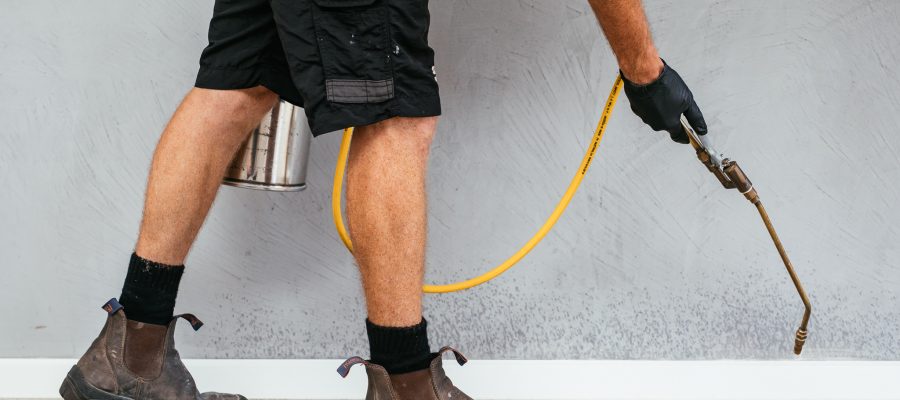13 Signs You May Have Termites
- June 24, 2019
- in Pest Control
- by Ashley Dando
- 319
- 0

Termites are very small yet very powerful creatures that can eat 24-7. If not stopped, they can cause serious damage to homes without giving any sign. The estimated economic damage caused by termites is around $336 billion per year worldwide. In Australia alone, the damage is estimated to more than 100 million dollars. It is necessary to regularly check for these 13 signs you may have termites, especially if you heard about infested homes in your neighbourhood. The earlier you discover them, the better it will be for your family.
Now let’s take a look at the most common signs of termites:
And by head banging we don’t mean your own head, but those of the insects. The soldier termites are banging their heads against the wood or shake their bodies to signal danger to the others in the colony.
The worker termites, which are the one eating your home are making quite some noise when doing it. If you put your head close to a wood infested by termites, you will hear them.
And if you like to listen to rock music out loud, the termites will eat even more. A study shown that when played a rock song, termites ate wood two times faster.
They are sensitive creatures and can detect vibrations and noises through their antennas and legs. It is even thought that termites can detect the size of a piece of wood by using vibrations to measure it.
This is one of the first signs of termites, as these flying insects are the ones who leave the nest in order to find a mate and establish a new colony. Some species are flying at night, while others during the day, but most of them like to fly after a rain, in certain moments of the year.

After they find a mate, the flying termites get rid of their wings. A male and a female will find a good nesting place and then will start mating. They will take care of the little ones until there are enough workers to take over. The so-called king and queen can establish a huge colony and can live happily ever after for 10 years or more. So if you see small wings around your home, it can be a sign of termite infestation.
Ants and termites have lots of similarities, and many people are confusing them. But they also have differences. For example, termites are white or translucent and their antennas are straight. Those of ants are bent.
Termites also have a thicker waist section, while ants have it narrow. Did you know that there are flying ants as well? Their front wings are larger than the back wings, while those of termites have both the same size.
The conclusion is that there are no white ants. So if you saw an insect that resembles a white ant, it was probably a termite and your home might be infested. You need to take action right away!
In order to be invisible and not show any signs of their activity, the termites are eating the wood from the inside out. So as they are eating it without you to notice, they are creating hollow galleries underneath the surface.
If you knock or tap and it sounds hollow, you may have a big problem. Many people are discovering that they have termites when accidentally pressing a finger on a door or wooden area. Since everything is eaten from the inside and there is just a thin external layer left, the finger simply goes through.
The termites still need a way to get to the wood, so they are drilling tiny holes. This could be another sign of infestation.
When termites are eating and tunnelling through a door or a window frame, they are creating moisture. This causes the wood to change its shape, thus making it more difficult to open and close the window/door.
Subterranean species of termites are building such tubes for extra protection and moisture. They are made of mud and termite droppings and usually appear in basements, subfloors and exterior walls, even in cupboards of your home termite can build mud leads or shelter tubes. Luckily, they are easy to spot and you should take action as soon as you see them see.
Termites mostly eat wood, but if needed, they can feed on just about anything that comes their way. This includes underground telephone wires, power wires and cables.
If short circuits occur on a regular basis without any apparent reason, termites might be the ones to blame. Not only this, but subterranean termites might fill the sockets with mud for protecting themselves.
Getting in contact with these wet sockets can be a hazard and can cause electrical shocks.
While these tunnels are difficult to spot from the outside, you might randomly notice them in a piece of broken timber. There are now various types of technology available that can detect such tunnels (borescopes, microwaves, infrared detectors, X-rays), and we can definitely help you with that.
Also known as frass, this can be a good detector of termite infestation, in particular, drywood termites. Unlike their subterranean relatives who are using their own faeces to build tunnels, the drywood termites are pushing them outside, through small holes.
So if you notice black spots or a dark powdery substance around your home, it’s time for an inspection.
As mentioned before, termites can feed on anything that comes in their path. This includes laminated floors, skirting boards, internal walls, wooden ceilings, beams, architraves and rafters.
If you notice sags or blisters in the floor, cracks in internal walls or damaged ceilings, then there is a high possibility of termite infection.
Most foundations are now made of concrete and luckily termites do not feed with it. Yet they can still find small cracks that allow them to gain access to floor joists which are made of wood.
Homes with cracks are at a higher risk of being attacked by termites, as well as old homes with a wooden foundation.
Finding termites in your garden may be a good thing, as they may not get to your house just yet. They can feed and damage timber decking and wooden fences, as well as trees.
Loose or broken roof tiles may cause moisture, which may attract termites, allowing them to enter the home. Once they are in, they can attack and destroy plenty of wood surfaces.
But this can be prevented if they are stopped in time. So make sure to quickly replace any damaged roof tiles.
Now you know the 13 signs you may have termites. Even though they are quite pests that like to destroy in silence, there are plenty of clues that may show their presence. It’s important to be careful at all of these sings and to take action immediately.
You may inspect your home on your own, but you still need the help of an expert. Safeguard Pest Control is a family-owned and operated company that has been operating since 1989. We have extensive knowledge and experience in this field and can provide you with professional results.
Our services have high standards and we offer pest solutions to residential, commercial and corporate areas, hospitals and schools. We are using the latest technology, in order to offer great results with no impact on your health or that of the environment.
We will begin by carefully inspecting your property, looking for any signs of termites and finding their nest. Depending on how bad the infestation is and on the particularities of your own home, we will come up with an action plan in order to eliminate them.
We have a wide range of treatment options, that suit all types of homes and all budgets. Our employees are highly trained and skilled and licensed to perform inspections and treatments. They will also advise you of any open access points where termites might enter in the future, so you can prevent their reappearance.
Early detection can save you a lot of money, so it’s better to act now than to be sorry later. Book your Safeguard Termite Inspection now by calling 07 5477 6675 or emailing info@safeguardpestcontrol.com.au and allow us to protect your greatest asset, your home.